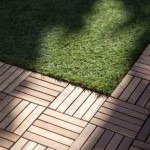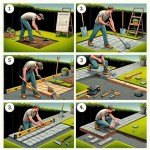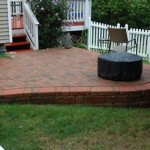How To Improve a Concrete Patio
A concrete patio provides a durable and versatile outdoor living space. However, over time, factors such as weather exposure, usage, and settling can diminish its appeal and functionality. Improving a concrete patio can involve a range of approaches, from simple cleaning and sealing to more extensive repairs and aesthetic enhancements. This article outlines several key methods for improving a concrete patio, focusing on practical techniques and considerations.
Addressing Cracks and Damage
Cracks are a common issue in concrete patios. They can arise from temperature fluctuations, ground movement, or excessive weight. Addressing cracks promptly is essential to prevent further deterioration and water infiltration, which can lead to more significant structural problems. The appropriate repair method depends on the size and nature of the crack.
For hairline cracks (less than 1/8 inch wide), a concrete crack filler or epoxy injection can effectively seal the crack and prevent water penetration. The process involves cleaning the crack thoroughly, removing any loose debris, and applying the filler or epoxy according to the manufacturer's instructions. It is crucial to choose a product specifically designed for concrete repair and compatible with the patio's existing sealant. The filler should be applied carefully to ensure it fills the crack completely and blends seamlessly with the surrounding concrete surface.
Larger cracks (greater than 1/8 inch wide) or those that exhibit significant movement require a more robust approach. In these cases, a concrete patching compound or sealant that is specifically designed for wider cracks is necessary. Before applying the patching compound, the crack should be widened and deepened slightly using a chisel and hammer to create a "V" shape. This provides a better surface for the patching compound to adhere to. The crack should then be cleaned thoroughly and primed, if recommended by the manufacturer of the patching compound. The patching compound is then applied in layers, ensuring it is properly compacted and feathered to blend with the surrounding concrete surface. After the patching compound has cured, it can be sanded smooth and sealed to protect it from the elements.
For severely damaged sections of the patio, such as areas with significant crumbling or spalling, a complete replacement of the affected concrete may be necessary. This involves removing the damaged concrete, preparing the sub-base, and pouring new concrete. This is a more extensive undertaking and may require professional expertise to ensure proper installation and avoid future problems. Prior to pouring new concrete, proper reinforcement, such as rebar or wire mesh, should be installed to provide additional strength and prevent future cracking.
Cleaning and Sealing
Regular cleaning and sealing are crucial for maintaining the appearance and longevity of a concrete patio. Cleaning removes dirt, grime, and stains that can accumulate over time. Sealing protects the concrete from water penetration, stains, and damage caused by freeze-thaw cycles.
The cleaning process should begin with sweeping the patio to remove loose debris. Afterwards, the patio should be washed with a pressure washer using a wide fan nozzle to avoid damaging the concrete surface. A diluted solution of mild detergent can be used to help remove stubborn stains. For oil stains, a specialized concrete degreaser may be required. After washing, the patio should be thoroughly rinsed with clean water and allowed to dry completely before sealing.
Concrete sealers come in various types, including acrylic, siloxane, and epoxy sealers. Acrylic sealers are generally the most affordable and easiest to apply, but they may not be as durable as other options. Siloxane sealers are more resistant to water penetration and are a good choice for patios exposed to harsh weather conditions. Epoxy sealers offer excellent durability and resistance to chemicals, but they can be more difficult to apply and may require professional installation. The choice of sealer depends on the specific needs and budget considerations.
Before applying the sealer, the concrete surface must be clean, dry, and free of any debris. The sealer should be applied according to the manufacturer's instructions, typically using a roller or sprayer. Multiple coats may be necessary to achieve the desired level of protection. It is essential to allow the sealer to dry completely between coats and before using the patio.
Sealing a concrete patio should be done periodically, typically every one to three years, depending on the type of sealer used and the amount of traffic the patio receives. Regular resealing helps to maintain the concrete's protection and extend its lifespan.
Enhancing Aesthetics
Beyond basic maintenance, there are several ways to enhance the aesthetic appeal of a concrete patio. These enhancements can transform a plain concrete slab into an attractive and inviting outdoor space.
Staining concrete is a popular method for adding color and visual interest. Concrete stains penetrate the surface of the concrete, creating a permanent and durable color. Acid stains react chemically with the concrete, producing unique and variegated color patterns. Water-based stains are more environmentally friendly and offer a wider range of colors. Both types of stains can be applied using a brush, roller, or sprayer, and the application technique can be varied to create different effects. Before staining, the concrete surface must be thoroughly cleaned and prepared to ensure proper stain penetration and adhesion. Sealing the stained concrete is essential to protect the color and prevent fading.
Another option for enhancing the aesthetics of a concrete patio is to apply a concrete overlay. Overlays are thin layers of concrete that are applied over the existing concrete surface. They can be used to create a variety of decorative finishes, such as stamped patterns, textures, and colors. Stamped concrete overlays mimic the look of natural stone, brick, or tile, providing a cost-effective alternative to these materials. Overlays are durable and resistant to wear and tear, making them a good choice for high-traffic areas. The application of a concrete overlay requires careful preparation of the existing concrete surface, including cleaning, patching, and priming. The overlay is then applied and finished according to the desired design. Sealing the overlay is essential to protect it from the elements and maintain its appearance.
Adding decorative elements to the patio can also significantly enhance its aesthetic appeal. This includes incorporating features such as planters, benches, fire pits, and outdoor lighting. Planters can be used to add greenery and color to the patio, creating a more inviting atmosphere. Benches provide comfortable seating for relaxing and entertaining. Fire pits create a focal point and provide warmth on cool evenings. Outdoor lighting can be used to highlight architectural features, create ambiance, and improve safety. The placement and design of these elements should be carefully considered to create a cohesive and functional outdoor space.
Another way to improve the look of the patio is to consider the surrounding landscaping. Planting flowers, shrubs, and trees around the patio can create a more natural and attractive setting. Adding a border of pavers or stones around the edge of the patio can also define the space and add visual interest. Mulching areas around the patio can help to suppress weeds and retain moisture. A well-designed landscape can complement the patio and create a seamless transition between the outdoor living space and the surrounding environment.
Grouting can be used to fill in gaps between paving stones or to add decorative touches to the surface of the patio. It can also help to improve the overall appearance of the patio and make it more durable. There are a variety of grout colors and textures available, so it is important to choose one that complements the existing concrete and the overall design of the patio.
By addressing cracks and damage, implementing regular cleaning and sealing practices, and considering aesthetic enhancements, a concrete patio can be transformed into a functional and attractive outdoor living space. The specific techniques and materials used will depend on the condition of the patio, the desired aesthetic, and budget considerations. The improvements discussed above will lead to a more visually appealing and durable patio.

9 Great Concrete Patio Ideas For A Makeover Remodelaholic

5 Simple Tweaks For A More Beautiful Concrete Patio

9 Great Concrete Patio Ideas For A Makeover Remodelaholic

Concrete Patio Ideas To Dress Up A Drab Space Bob Vila

6 Concrete Patio Ideas To Boost The Appeal Of That Drab Slab

Concrete Patio Ideas To Dress Up A Drab Space Bob Vila

5 Simple Tweaks For A More Beautiful Concrete Patio

Easy Concrete Patio Coverup Ideas The Garden Glove

5 Simple Tweaks For A More Beautiful Concrete Patio

3 Concrete Resurfacing Options For Patio
Related Posts








